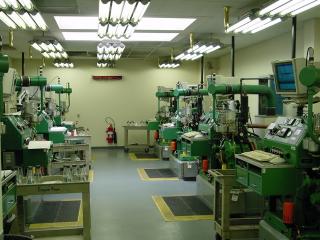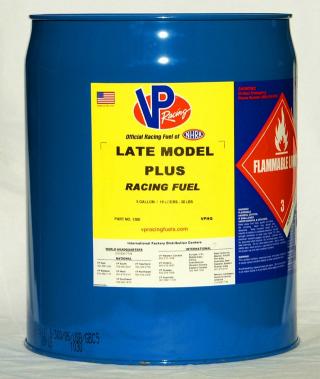Every racer wants an advantage; it’s in our very nature. Sometimes we overlook the simple stuff and the importance of what is fueling our race car. So what is the magic “rocket” fuel to launch you quicker and faster than the next guy to victory lane? What fuel is best for your hot street steed? You know what octane rating means, but what about all those other chemical terms used to rate fuel? Follow along while the specialists at VP Racing Fuels, Freddie Turza for Circle Track applications and Jason Rueckert for hot street cars and drag racing, explain the basics of racing fuel, what the terms mean, and how to pick the correct fuel for you needs.
 Your author is a former INEX Legends Car racer (5/8th scale ’34 Ford Coupe powered by 1250cc Yamaha motors, racing on ¼ to ½ mile ovals), and knows the importance of having the right fuel in the fuel cell. Champion Legends racer Kevin Yeatts explains it this way, “Let me just say that VP Fuels did an excellent job of making U4 and VP006 (formerly VP600). These oxygenated fuels quite literally make non-oxygenated fuels obsolete. If I show up at a speed track (like Kenly or South Boston or Shenandoah or Caraway) with Brand-X Fuel and there are guys there running oxygenated VP006 I am literally giving up as much as half a second a lap’s worth of horsepower”.
Your author is a former INEX Legends Car racer (5/8th scale ’34 Ford Coupe powered by 1250cc Yamaha motors, racing on ¼ to ½ mile ovals), and knows the importance of having the right fuel in the fuel cell. Champion Legends racer Kevin Yeatts explains it this way, “Let me just say that VP Fuels did an excellent job of making U4 and VP006 (formerly VP600). These oxygenated fuels quite literally make non-oxygenated fuels obsolete. If I show up at a speed track (like Kenly or South Boston or Shenandoah or Caraway) with Brand-X Fuel and there are guys there running oxygenated VP006 I am literally giving up as much as half a second a lap’s worth of horsepower”.
Yeatts continued, “As an example, I showed up at Kenly two weeks ago with Brand-X Fuel in my car from the race the previous week at Shenandoah and I was over half a second off the pace. I was ready to load the car up and head home! Fortunately, I had a 5 gallon pail of VP006. I drained the tank on my car and filled it with the VP006 and headed back out for the second round. With no other changes, I picked up half a second and I was right there with the lead pack. A few other changes before the race made the car a little more comfortable and competitive, but no other change I made was nearly as significant. It was not even close”. Racers kill and/or sell their first born for a half second on the track! That’s the importance of the right fuel.
Most racing sanctioning bodies regulate the types of fuels you can run. They’ll use terms like: Octane (both Motor & Research), Specific Gravity, Oxidation Stability, Distillation, Reid Vapor Pressure and E.P. Knowing what your rules are before you pick a fuel, will save the embarrassment and shame of disqualification!
Octane: This rating is a measure of the resistance of fuel to auto-ignition (spontaneously ignite, premature detonation, knocking or ping) in spark-ignition internal combustion engines. The higher the number, the more resistant the fuel is to auto-ignition. It might seem odd that fuels with higher octane ratings are used in more powerful engines, since the fuel ignites less easily. However, an uncontrolled ignition is a BAD THING! A fuel with a higher octane rating can be run at a higher compression ratio without causing detonation and we know compression or boost is directly related to power. You’ll see two common methods for measuring octane: Research Octane Number (RON) and Motor Octane Number (MON).
RON is a measure of how resistant gasoline is to premature detonation, i.e., knocking. It is measured relative to a mixture of 2,2,4-trimethylpentane (an octane) and n- heptane. So an 87-octane gasoline has the same knock resistance as a mixture of 87% isooctane and 13% n-heptane. Its definition is also based on the mixture of isooctane and n-heptane that has the same performance. Depending on the composition of the fuel, the MON of a modern gasoline will be about 10 points lower than the RON octane. Normally fuel specifications require both a minimum RON and a minimum MON.
On gas pumps in United States the octane number is the average of the RON and the MON, sometimes called the “roaD Octane Number” or DON, or (R+M)/2. Because of the 10 point difference noted above this means that the octane in the US will be about 5 points lower than the same fuel elsewhere: 87 octane fuel, the “normal” gasoline in the US and Canada, would be 92 in Europe. Both RON & MON are measured by running the fuel thru a test engine with variable compression ratio, but MON is a better indicator of octane when under load as it is done at 900 rpm instead of the 600 rpm of the RON test. So for racing, the MON is of more importance since the conditions more closely represent racing conditions than that of the RON.
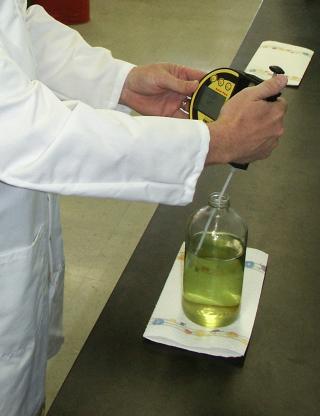
Minazzi tests for specific gravity using a digital meter to ensure the the fuel is in compliance with specifications.
Specific Gravity: This is the relative density of the fuel compared to that of water when measured at 60 degrees Fahrenheit. Imagine a gallon bottle filled with water, a second filled with feathers, a third filled with lead weights. There are equal volumes of material present, but the bottle with the feathers will weigh less than that containing water; the bottle with lead weights will weigh the most. Energy content is measured in British Thermal Units (BTU) per gallon and is related to the fuel’s specific gravity and the temperature range at which it vaporizes. The BTU content per unit volume increases as the specific gravity increases. For example, the BTU content of a gallon of diesel fuel is higher than that of gasoline and fuels with a higher specific gravity will provide improved power and fuel economy.
The relative density can be measured by several methods. One of these methods (ASTM D1298) utilizes a glass bulb (hydrometer) that will float a particular height above the surface of the fuel contained in a cylinder at 60 degrees Fahrenheit. The higher the hydrometer floats, the higher the specific gravity of the fuel. Typically, the specific gravity decreases as the temperature of the fuel increases and increases as the temperature of the fuel decreases.
Oxidation Stability: This measures a fuel’s resistance to form gums by recording the time it takes for a fuel to break down with oxygen, pressure and heat. A higher time value would indicate a more chemically stable fuel. The method uses a fuel sample pressurized to 100 psi with oxygen and heated to 100 degrees Celcius (212F) until a significant oxygen uptake is measured.
Reid Vapor Pressure (RVP): Fuels can contain components that yield high amounts of vapors, which may affect starting, warm-up, and tendency to vapor lock with high operating temperatures or high altitudes. One method for checking a fuel’s vapor forming tendency is by the Reid Vapor Pressure Method. This method uses a chilled sample of fuel that is put inside a vapor pressure apparatus and heated to 100 degrees Fahrenheit in a bath. The pressure inside the vapor pressure apparatus is monitored until a constant pressure is observed.
Distillation: This is the process of heating a fuel until it completely evaporates. A sample of fuel is put into a flask of the distillation apparatus and heated accordingly. As the fuel is heated, various fractions are evaporated and then recollected and recorded. Since racing fuel is made of several components it will evaporate over a range of temperatures and not just at one point.
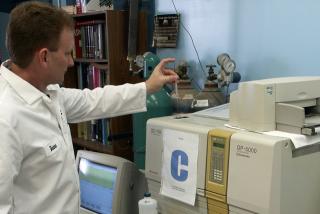
A gas chromatograph is used by Minazzi to verify blended fuels contain the correct composition prior to drumming and shipping.
E.P.: This is an acronym for the end point of a distillation. When a fuel is distilled, the initial boiling point (IBP), 10%, 50%, 90% distilled, and end point (E.P.) at which the fuel is finished distilling are typically measured to show the fuels ability to evaporate under different temperature conditions.
Here at powerTV Command Central, we use three of the most popular VP Fuels: C14 and VP100 for Street/Strip projects and for the dirt track we use VP’s CHP designed for crate engines. Jason Rueckert from VP described VP100, “This is a street legal unleaded performance fuel, specifically engineered for high-performance street cars, exotics, sport compacts, muscle cars, street rods and vehicles requiring premium fuels in excess of 91 octane. Oxygenated with ethanol, VP100 is environmentally friendly, meets California Air Resource Board (CARB) requirements and is street legal throughout the U.S”. Rueckert continued, “At 100 octane (R+M/2), it generates substantial power increases over pump gas. A test with a turbocharged application proved VP100 will generate up to 14% more power than a premium grade 91 octane unleaded gasoline.”
Jason also told us, “VP100 is safe for use in cast-iron head engines with compression ratios up to 12:1 and aluminum heads up to 14:1 and reduces the fear of detonation in power enhanced vehicles. It contains no metal compounds and will not harm catalytic converters or oxygen sensors. It’s designed to enhance performance in the latest generations of turbo- and supercharged engines. In turbocharged or supercharged applications, it allows an increase in boost without fear of detonation and Nitrous users can also leverage their higher octane ratings to step up to a more powerful nitrous oxide system.”
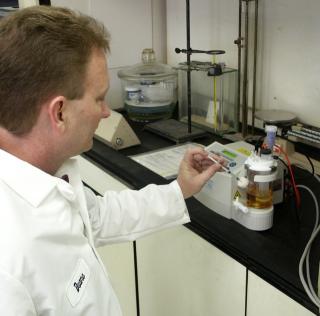
Duane Minazzi, uses coulemetric titration to detect the presence of water in solution, an important test particularly for oxygenates introduced to fuel blends.
In areas where premium fuels such as 93 octane are unavailable, VP100 is the perfect solution. Over 200 cars currently in production suggest premium fuel for optimum performance. “You can also blend VP100 with your local premium fuel to give you the desired octane number to meet the maximum performance standards of your vehicle”, Jason said.
VP’s C14 is a leaded (not for use with catalytic converters!) racing gas with a Motor Octane of 114. Jason said, “We recommended this one for naturally aspirated engines operating at over 8000 RPMs with compression ratios of 14:1 and higher. It’s the spec fuel for NHRA Comp Eliminator, NMRA and NMCA”.
For blown engines (turbo- or super-charged) and nitrous applications, Jason lauds the new Q16, “This is a leaded fuel that can be used in compression ratios up to 17:1. The MON Octane is 116. It’s highly oxygenated, requiring a 4-6% increase in fuel flow and makes 3-5% more power than competitors’ 116 octane fuels and provides better protection against detonation. Oxygenation expands the range of air/fuel ratio acceptability, offering more consistent performance from run to run and it won’t vary as much with altitude or density changes.”
Jason recommends VP’s NO2 for nitrous users, “This is another leaded fuel specifically for fogger or three-stage nitrous oxide applications with CRs up to 18:1. It has higher octane (MON 120+) and lower specific gravity than most nitrous fuels. It may require enriching fuel mixture more than C16 would require. C16 is our MON 117 Octane fuel for turbocharged engines, blown engines and nitrous applications with CRs up to 17:1. It’s recommended by the top nitrous oxide companies and is the Spec Fuel for NHRA Comp Eliminator”.
For Circle track fuel, Freddie Turza described VP’s CHP fuel, “CHP, which stands for ‘Crate HorsePower’, and is leaded. It will make 15-20 more horse power than premium pump gas, but perhaps the biggest benefit the racer will see is the ‘wide’ tuning window. Over the last several years VP’s MS109 has become the fuel of choice for serious crate late model racers, but CHP will not only make 1.5% more HP than MS109, it actually costs less. CHP will also outperform E85 by 4-6% in HP, and significantly, requires carrying about 50% less weight in fuel compared to E85”.

Lynn Geisler, National Dirt Late Model Hall of Famer claims the VP Racing Fuel is the best gain vs. cost.
We asked Freddie, why CHP outperforms the standard MS109, “The key to CHP’s performance is better fuel vaporization, which improves fuel distribution and burning speed. Due to its oxygenation, CHP has to run 4-7% richer than non-oxygenated fuels. Running richer with better fuel distribution effectively adds 2-3 octane numbers and provides even more on-track protection against detonation than its standard ASTM motor octane rating would indicate. We do not recommend it for boost or nitrous applications, or for applications with compression ratios over 12.5:1 though”.
We then asked Turza for the details on MS109: “In engines that can run on pump gas, MS109 is a direct replacement that produces more power than any other unleaded fuel – up to 5% more than premium unleaded. Recommended for applications with up to 25 pounds of boost and naturally aspirated engines with CRs up to 15:1. When compared to other unleaded fuels, it offers better detonation protection as well. It’s still excellent in crate engine applications”.
Freddie told us the story of Lynn Geisler, winner of 200+ feature races and member of the National Dirt Late Model Hall of Fame, who tried CHP and liked it, “MS109 made 8-10 more HP compared to anything else we tried, and CHP gave us 8 more HP on top of that. Besides that, both MS109 and CHP burn cleaner and keeps the water temperature low so it saves wear and tear on my engine. In my mind, CHP gives me the best gain vs. cost of any performance part I could put on the car.”
Turza gave a ringing endorsement for C12, “This is a leaded fuel with better vaporization and greater energy value. C12 makes 4-5 more horsepower than competitive fuels with comparable octane ratings”. Freddie has heard from Craig Von Dohren, a top Northeast winner in big block Modified competition with more than 200 career feature wins. “C12 makes more power than other fuels, but its cooling effect is even more critical. Big block engines are expensive and can really be hurt by overheating. By running cooler, C12 protects my engine and helps ensure I’ll make it to the finish”. C12 is for use in naturally aspirated engines with CRs up to 15:1.
VP’s premier fuel for circle track applications, is Late Model Plus. Explained Freddie, “It’s recommended for use on 3/8 mile or greater dirt and asphalt circle tracks in engines bigger than 400 ci and compression ratios up to 15:1. Late Model Plus is more effective than any fuel on the market at making more power while suppressing engine operating temperatures. Its motor octane (MON) is 113, the highest of any comparable competitive fuel. As a result, it offers what Larry Clark, of Custom Race Engines, describes as ‘a wider tolerance range in tuning, a greater safety blanket for detonation and it’s more forgiving in extreme conditions.’ With a relatively low RVP rating, Late Model Plus also prevents problems associated with vapor lock. It’s preferred by other top engine builders including Pro Power Racing and many others. It’s the fuel of choice for top drivers including Scott Bloomquist, Steve Francis, Tim McCreadie and many others”.
VP Racing Fuels has been around for more than 30 years and its strength has been its dedication to technological innovation through R&D, making VP Racing Fuels an industry leader. Turza told us, “We started with the philosophy that the only thing that counts is winning and that continues today”. Jason continued, “We work directly with racers at the track and on their dynos. It’s how we started and continues to be our M.O. today, with most of our R&D accomplished in this manner. True champions leave no stone unturned in their drive to win”. If you’re unsure of the right fuel for your application, help and increased performance is available from VP for those bold enough to ask.




